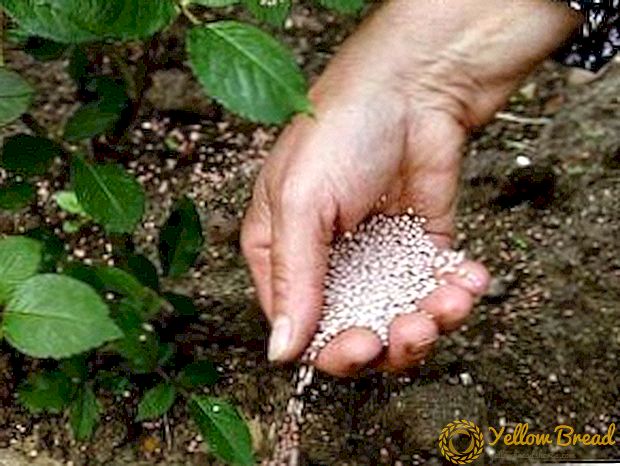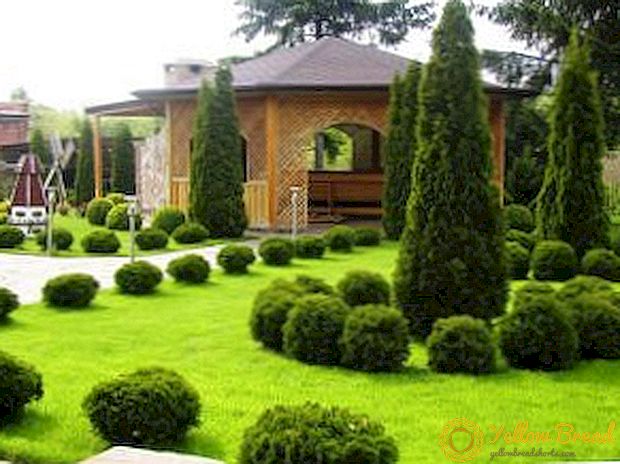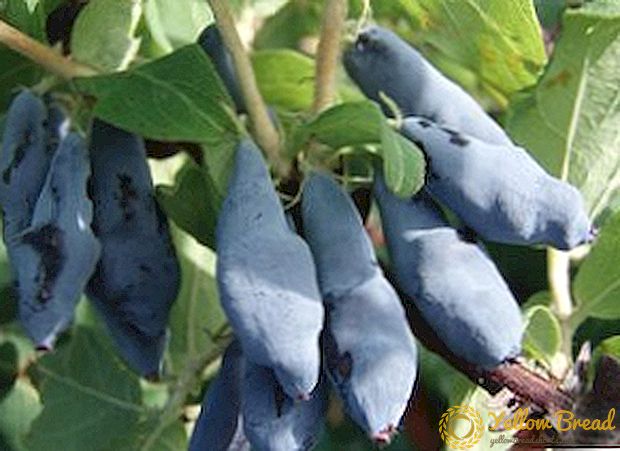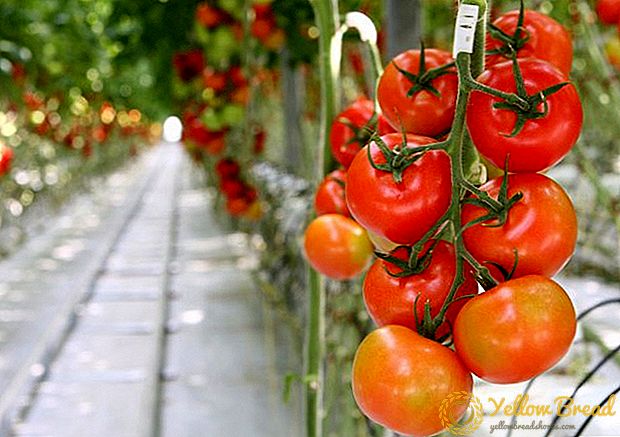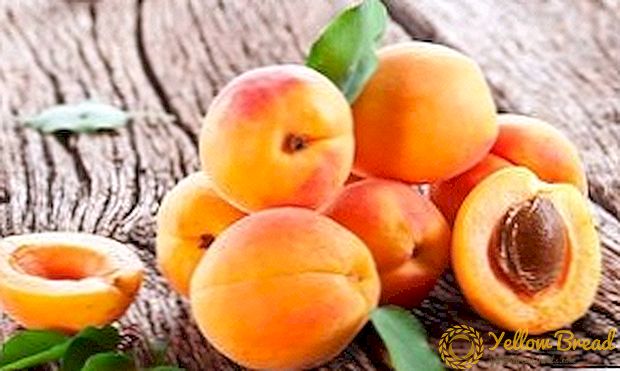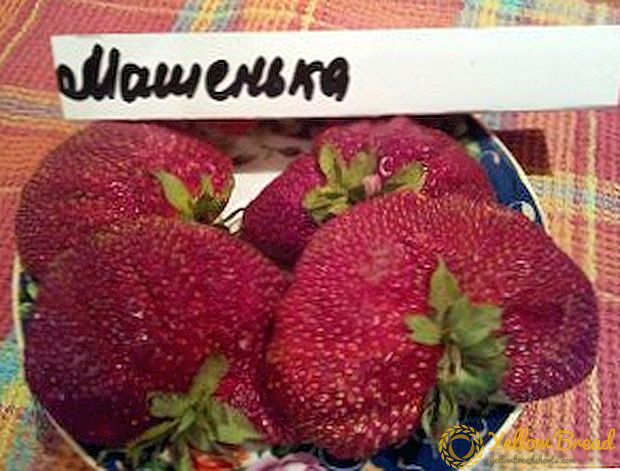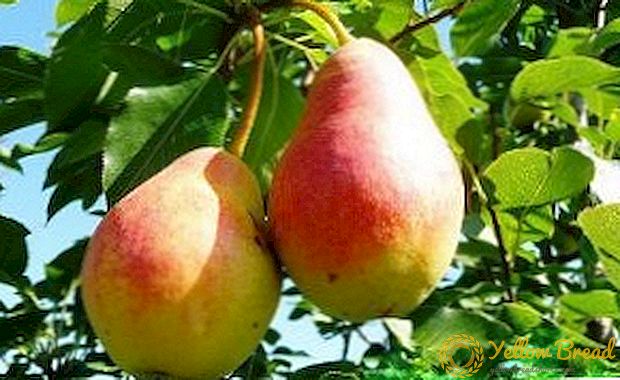 If you decide to plant a pear on the plot, you should carefully select the variety. Our article will describe the "Red-sided" pear, as well as provide its characteristics. We will tell you how to plant a tree and take care of it.
If you decide to plant a pear on the plot, you should carefully select the variety. Our article will describe the "Red-sided" pear, as well as provide its characteristics. We will tell you how to plant a tree and take care of it.
- Breeding history and region of breeding
- Characteristics and features
- Wood
- Fruits
- How to choose seedlings when buying
- The choice of space
- Preparatory work
- Step-by-step process of planting seedlings
- Seasonal care features
- Soil care
- Top dressing
- Preventive treatment
- Pruning
- Protection against cold and rodents
Breeding history and region of breeding
The cultivation of the variety was carried out by the scientific organization of agricultural science of the FGBNU YuUNIISK. Variety pears "Krasnobokaya" turned out due to the crossing of two varieties: "Yellow-fruit" and "Tenderness".
Originators Such breeders as: Putyatin V.I., Mazunin M.A., Falkenberg E.A. In the early 90s of the last century, state tests of this variety began."Krasnobakaya" pear is listed in the State Register of the Volga-Vyatka, Ural and Altai regions, also found in Western Siberia. 
Characteristics and features
We offer to your attention the description of the pear variety "Krasnobokaya".
Wood
This variety is characterized by trees whose height can exceed 4 meters. Young trees are distinguished by a powerful progressive growth. Pear has an oval, branchy, sparse crown. Stems have the correct form, located at 90 degrees to the trunk. The tips of the branches are directed to the top of the tree. The bark and skeletal stems are colored brown, peeling is inherent in them.
Active growth of the tree continues until the period of fruiting begins. The leaves are light emerald in color, have a slight waviness at the edges, without edge. The size is quite large, elongated and thick.
Fruits
Fruits are medium in size, sometimes slightly larger than normal. The weight of one pear is approximately 135-155 g but specimens with a mass of 180 g can also be found. The shape of the fruit is a classic pear-shaped. They have a smooth surface, pleasant skin. During the collection of pears have emerald color,but over time they become amber by one third. They have fine-grained white flesh with a pleasant aroma.  Pear has juiciness: when biting, juice just starts to flow out of it. It is famous for its sweet taste, successfully combined with a slight sourness and tartness. A few days after the collection of astringency will not remain a trace, and you can enjoy the excellent taste of pear.
Pear has juiciness: when biting, juice just starts to flow out of it. It is famous for its sweet taste, successfully combined with a slight sourness and tartness. A few days after the collection of astringency will not remain a trace, and you can enjoy the excellent taste of pear.
How to choose seedlings when buying
Ideal for landing are seedlings, which age is 1-2 years. The height of a young tree should be about 1 meter. In the upper middle of the trunk should be a lot of strong kidneys. Biennial seedlings should have 2-3 side shoots, which must be in the order of the presence of buds. When purchasing a pear, pay attention to the root system - it must contain at least 3 processes with many branches. The presence of dry branches is unacceptable.
The choice of space
Pear is planted on windless stretchon which there are no drafts. The tree loves the sunlight, so you should not plant it near the house or other buildings. It is better to retreat from them by 3-4 meters. For planting, select areas with sandy soil, black soil or loamy soil.
 The acidity level should be pH 5.6-6. It is recommended to plant the plant on elevations, in areas where groundwater is at least 2.5 meters under the ground.
The acidity level should be pH 5.6-6. It is recommended to plant the plant on elevations, in areas where groundwater is at least 2.5 meters under the ground.
Pollinator for pears can be such varieties as: "Northerner", "Myth" and "Hanged".
They are recommended to be planted near the tree.
Preparatory work
If you are planning to plant a tree in the northern regions, then the event is best done in spring. If planting is planned in warm areas, it is possible to plant a pear in the autumn. The preparation of the landing pit should be held in the fall, for 10-14 days before disembarking.
- From the landing place, take a layer of soil of 20-25 cm and combine it with 20 kg of organic fertilizers (compost or humus can be used), 15 kg of river sand and 0.3 kg of superphosphate.
- Then it is necessary to dig a hole, the diameter of which will be equal to 70 cm, and the depth - at least 1 m. If, nevertheless, the groundwater flows close, it is necessary to make a drainage using pebbles.
- Pour the prepared soil into the pit.
- Cover the pit with plastic wrap.
Step-by-step process of planting seedlings
Before planting, the root system of the seedling is treated with a 3% solution of potassium permanganate. It is necessary to dip the seedling in this solution and keep it in it for at least a day. Then it is worth smearing the roots with a pre-prepared mixture of manure and powdered clay in a 1: 2 ratio. The seedling should dry in 2-3 hours. Consider how the tree is planted:
- Remove plastic film from the pit, hammer in a stake 4-5 cm from the center of the pit, which will serve as a support for the wood.
- Form in the center of the pit a small hill of soil.
- Place a tree in the center of the pit, and the root neck should be 6 cm above ground level.
- Carefully flatten the root system on the hill.
- Sprinkle roots with soil, slightly tamping each layer. Take care that no voids form.
- Tie a sapling to the support.
- At the edges of the pit, build a groove, the depth of which should be 7-9 cm. Water the seedling (20 liters of water).
- Pour the mulch in the tree circle, it will help keep moisture in the soil.
- Sapling shoots must be cut by 30%.
As you can see, the planting procedure is quite simple and even a novice gardener can handle it. 
Seasonal care features
Consider how to care for the tree so that it gives a tasty and rich harvest.
Soil care
Pear does not need frequent watering - enough moisten the soil 4 times per season. However, if summer is dry and rains are very rare, the amount of watering should be increased. In the presence of dry weather, it is recommended to water the tree once a week, at the same time to mulch the tree trunk. For this ideal peat or humus.This event will retain moisture around the root system and will prevent the appearance of a crust on the ground.
One of the features of tree care - sprinkling. The event should be held in the morning or in the evening with warm water.
After watering, it is recommended to loosen the soil, which will enrich the soil with oxygen.
With the growth of weeds in weeds, weeding is carried out. Weeds take away many useful substances, so it is necessary to ensure that the near-stem circle was cleared of them. 
Top dressing
Since the root system is located deep underground, there is no point in spilling fertilizer on the soil surface. The best option is to irrigate using nutrient solutions.
The use of exclusively mineral dressings can lead to acidification of the soil, therefore it is worth using organic fertilizers. Mineral supplements are made every year, organic - once in 2-3 years. An adult tree requires 25-30 kg of organic fertilizer.You can use humus, compost or manure.
Thanks to mineral fertilizers, the tree develops better. To carry out the procedure of feeding is as follows:
- before the pear begins to bloom, it is necessary to feed it with 450 g of urea or 45 g of saltpeter;
- after the end of the flowering period, it is necessary to add another 250 g of urea, and also to spray the buds with its 3% solution;
- in the autumn, 60 g of double superphosphate, 30 g of potassium and 30 g of calcium are introduced.
Preventive treatment
To prevent pests and various diseases from attacking the tree, it is necessary to carry out prophylactic treatment before the flowering period. To purchase drugs, you should contact a specialized store where you will be offered funds, depending on what you want to do the treatment against. 
Pruning
The first 4-5 years after disembarkation, it is necessary to pay special attention to the formation of the crown and to prune the tree. It is better to carry out this event in the spring, in the third decade of April. Most often it is possible to meet the longline structure of the crown.
- In the second year after disembarkation, you need to choose 3-4 strong branches, which are located in the lower part of the tree, and cut off all other shoots. Also, the main trunk is shortened by 20-25 cm.
- For the next season it is necessary to form the second tier. It should be no less than 40 cm from the first one. You need to leave 2-3 branches, and cut off all the other shoots. The branches located between the tiers should be shortened by 2/3. Also, the main trunk is shortened by 25-30 cm.
- In the fourth year of growth, the formation of the third tier is carried out. Leave 1 or 2 branches. For the next season, it is necessary to shorten the main trunk so that it is on the same level with the third tier.

Protection against cold and rodents
Pear "Red-sided" refers to trees with high frost resistance. Young saplings should be warmed with fir paws or burlap, and mature trees should be prepare for winter as follows:
- remove the branches, leaves, fruits and debris from the circle;
- it is recommended to dig up the near-stem circle in order to eliminate pests;
- it is necessary to whitewash the trunk and 1/3 of the branches located in the lower tier. To do this, you will need 2 kg of lime, 1 kg of powdered clay and 300 g of copper sulphate;
- At the last stage, the plant is mulched. The layer of sawdust or peat must be at least 15-20 cm.It is very important with the arrival of spring to remove the mulch in time, otherwise it will cause overheating and rotting of the root system.
Pear "Red-sided" is characterized by resistance to many diseases and pests. It rarely affects cytosporosis, powdery mildew and scab, pear gall mites, aphids and leafworms. However, you can take preventive measures to prevent the appearance of diseases and pests on the plant.  If you decide to plant a pear on the plot, we recommend that you choose the variety Krasnobokaya. The tree is unpretentious in care, so you can grow it with little effort and enjoy a tasty and rich harvest.
If you decide to plant a pear on the plot, we recommend that you choose the variety Krasnobokaya. The tree is unpretentious in care, so you can grow it with little effort and enjoy a tasty and rich harvest.

